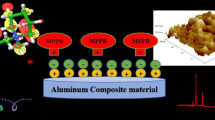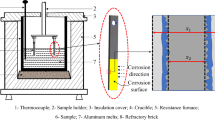Abstract
The phenomenon of localized damage of aluminum oxide surface in the presence of halide anions was scrutinized at an atomistic level, through the cluster approach and density functional theory. The phenomenon was also investigated empirically through Tafel polarization plots and scanning electron microscopy. A distinct behavior witnessed in the fluoride medium was justified through the hard-soft acid-base principle. The atomistic investigations revealed the greatest potency for chloride entrance into the metal oxide lattice and rationalized to the severity of damage. The interaction of halide anions with the oxide surface causing some displacements on the position of Al atoms provides a mechanistic insight of the phenomenon.





Similar content being viewed by others
References
J. Zhang, M. Klasky, and B.C. Letellier, The Aluminum Chemistry and Corrosion in Alkaline Solutions, J. Nucl. Mater., 2009, 384, p 175–189
B. Zhang, Y. Li, and F. Wang, Electrochemical Behavior of Microcrystalline Aluminum in Neutral Fluoride Containing Solutions, Corros. Sci., 2009, 51, p 268–275
S. Sadeghipour, J. Ghaderian, and M.A. Wahid, Advances in Aluminum Powder Usage as an Energetic Material and Applications for Rocket Propellant, AIP Conf. Proc., 2012, 1440, p 100–108
R.E. Sanders, Jr., and D.M. Farnsworth, Trends in Aluminum Materials Usage for Electronics, JOM, 2011, 63, p 12–15
C. Vargel, Corrosion of Aluminium, Elsevier, Oxford, 2004
G.S. Frankel, Pitting Corrosion of Metals: A Review of the Critical Factors, J. Electrochem. Soc., 1998, 145, p 2186–2198
E. McCafferty, Sequence of Steps in the Pitting of Aluminum by Chloride Ions, Corros. Sci., 2003, 45, p 1421–1438
W.M. Carroll, M. Murphy, and C.B. Berslin, The Corrosion/Dissolution Behaviour of Aluminium in Solutions Containing Both Chloride and Fluoride Ions, Corros. Sci., 1993, 34, p 1495–1507
E.J. Lee and S.I. Pyun, The Effect of Oxide Chemistry on the Passivity of Aluminum Surfaces, Corros. Sci., 1995, 37, p 157–168
P.J. Eng, T.P. Trainor, G.E. Brown, G.A. Waychunas, M. Newville, S.R. Sutton, and M.L. Rivers, Structure of the Hydrated α-Al2O3 (0001) Surface, Science, 2000, 288, p 1029–1033
T.H. Nguyen and R.T. Foley, The Chemical Nature of Aluminum Corrosion, J. Electrochem. Soc., 1982, 129, p 27–32
M. Lashgari and A.M. Malek, Fundamental Studies of Aluminum Corrosion in Acidic and Basic Environments: Theoretical Predictions and Experimental Observations, Electrochim. Acta, 2010, 55, p 5253–5257
M. Lashgari, Theoretical Challenges in Understanding the Inhibition Mechanism of Aluminum Corrosion in Basic Media in the Presence of Some p-Phenol Derivatives, Electrochim. Acta, 2011, 56, p 3322–3327
E.M. Sherif and S.-M. Park, Effects of 1,4-Naphthoquinone on Aluminum Corrosion in 0.50 M Sodium Chloride Solutions, Electrochim. Acta, 2006, 51, p 1313–1321
M. Lashgari, M.R. Arshadi, Gh.A. Parsafar, and V.S. Sastri, Cluster/Polarized Continuum Models for Density Functional Theory Investigations of Benzimidazole Corrosion Inhibitors at Metal/Solution Interface, Corrosion (Houston), 2006, 62, p 199–206
M. Lashgari, M.R. Arshadi, and V.S. Sastri, Quantum Electrochemical Approaches to Corrosion Inhibition Properties of Some Aniline Derivatives in Acidic Media, J. Electrochem. Soc., 2007, 154, p P93–P100
J.-L. Quan, B.-T. Teng, X.-D. Wen, Y. Zhao, R. Liu, and M.-F. Luo, Hydrogen Fluoride Adsorption and Reaction on the α-Al2O3(0001) Surface: A Density Functional Theory Study, J. Chem. Phys., 2012, 136, p 114701–114708
V.A. Ranea, I. Carmichael, and W.F. Schneider, DFT Investigation of Intermediate Steps in the Hydrolysis of α-Al2O3(0001), J. Phys. Chem. C, 2009, 113, p 2149–2158
P. Gamallo and R. Sayós, A Density Functional Theory Study of Atomic Oxygen and Nitrogen Adsorption Over α-Alumina (0001), Phys. Chem. Chem. Phys., 2007, 9, p 5112–5120
Ø. Borck, P. Hyldgaard, and E. Schröder, Adsorption of Methylamine on α-Al2O3(0001) and α-Cr2O3(0001): Density Functional Theory, Phys. Rev. B, 2007, 75, p 035403–035407
V. Shapovalov and T.N. Truong, Ab Initio Study of Water Adsorption on α-Al2O3 (0001) Crystal Surface, J. Phys. Chem. B, 2000, 104, p 9859–9863
J.M. Wittbrodt, W.L. Hase, and H.B. Schlegel, Ab Initio Study of the Interaction of Water with Cluster Models of the Aluminum Terminated (0001) α-Aluminum Oxide Surface, J. Phys. Chem. B, 1998, 102, p 6539–6548
M.R. Arshadi, M. Lashgari, and Gh.A. Parsafar, Cluster Approach to Corrosion Inhibition Problems: Interaction Studies, Mater. Chem. Phys., 2004, 86, p 311–314
B.J. Lynch and D.G. Truhlar, Small Basis Sets for Calculations of Barrier Heights, Energies of Reaction, Electron Affinities, Geometries, and Dipole Moments, Theor. Chem. Acc., 2004, 111, p 335–344
M.J. Frisch, G.W. Trucks, H.B. Schlegel, G.E. Scuseria, M.A. Robb, J.R. Cheeseman, G. Scalmani, V. Barone, B. Mennucci, G.A. Petersson, H. Nakatsuji, M. Caricato, X. Li, H.P. Hratchian, A.F. Izmaylov, J. Bloino, G. Zheng, J.L. Sonnenberg, M. Hada, M. Ehara, K. Toyota, R. Fukuda, J. Hasegawa, M. Ishida, T. Nakajima, Y. Honda, O. Kitao, H. Nakai, T. Vreven, J.A. Montgomery, Jr., J.E. Peralta, F. Ogliaro, M. Bearpark, J.J. Heyd, E. Brothers, K.N. Kudin, V.N. Staroverov, R. Kobayashi, J. Normand, K. Raghavachari, A. Rendell, J.C. Burant, S.S. Iyengar, J. Tomasi, M. Cossi, N. Rega, J.M. Millam, M. Klene, J.E. Knox, J.B. Cross, V. Bakken, C. Adamo, J. Jaramillo, R. Gomperts, R.E. Stratmann, O. Yazyev, A.J. Austin, R. Cammi, C. Pomelli, J.W. Ochterski, R.L. Martin, K. Morokuma, V.G. Zakrzewski, G.A. Voth, P. Salvador, J.J. Dannenberg, S. Dapprich, A.D. Daniels, Ö. Farkas, J.B. Foresman, J.V. Ortiz, J. Cioslowski, and D.J. Fox, Gaussian 09, Revision A.02, Inc., Wallingford, CT, 2009
H. Walters, Design of Corrosion Inhibitors: Use of the Hard and Soft Acid-Base (HSAB) Theory, J. Chem. Educ., 1991, 68, p 29–30
E.S. Böes, P.R. Livotto, and H. Stassen, Solvation of Monovalent Anions in Acetonitrile and N,N-Dimethylformamide: Parameterization of the IEF-PCM Model, Chem. Phys., 2006, 331, p 142–158
J.R. Galvele, Transport Processes and the Mechanism of Pitting of Metals, J. Electrochem. Soc., 1976, 123, p 464–474
A.S. Mikhailov, J.R. Scully, and J.L. Hudson, Nonequilibrium Collective Phenomena in the Onset of Pitting Corrosion, Surf. Sci., 2009, 603, p 1912–1921
Author information
Authors and Affiliations
Corresponding author
Rights and permissions
About this article
Cite this article
Lashgari, M., Kianpour, E. & Mohammadi, E. Aluminum Pitting Corrosion in Halide Media: A Quantum Model and Empirical Evidence. J. of Materi Eng and Perform 22, 3620–3625 (2013). https://doi.org/10.1007/s11665-013-0669-x
Received:
Revised:
Published:
Issue Date:
DOI: https://doi.org/10.1007/s11665-013-0669-x




